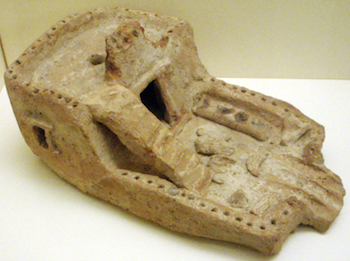The First Intermediate Period was traditionally described as a low point in ancient Egyptian history, largely because the information we have regarding this period is sketchy and often contradictory but also because to some it marks a nadir in Egyptian culture, art, and architecture. Some Egyptologists have challenged this view of the period and asked the question was the First Intermediate Period a “dark age”.


It is generally agreed that the centralised state collapsed shortly after the rule of Pepi II. Pepi was in his nineties when he passed away. He survived many of his heirs but left a large number of people with tenuous claims to the throne and there were significant successional difficulties following his departure. There also seem to have been problems caused by the rise in the power of certain noble families. As if this was not enough, there may also have been unpredictable fluctuations in the level of the inundation which caused widespread famine and instability during which the temples were pillaged and art works vandalised. Pharaonic authority buckled under the pressure and powerful “nomarchs” tried to step into the breach and take control of Egypt.
Between the end of the Old Kingdom and the beginning of the Middle Kingdom there were three centres of power competing for supremacy: Memphis (the seat of power in the Old Kingdom and dynasties seven and eight), Hierakliopolis (home of the rulers of dynasties nine and ten) and Thebes (the home of the rulers of the eleventh dynasty and the Middle Kingdom).
Confirming the chronology of this turbulent time is far from easy. Manetho is often criticised for accepting fable as fact, and this problem is compounded by the fact that we do not have a complete version of his works, only excerpts from later writers. Unfortunately, these versions do not always agree. The Saqqara Kings List ends with Pepi II of the sixth dynasty, ignores the seventh, eighth, ninth and tenth dynasties and jumps to Montuhotep II of the eleventh dynasty (Middle Kingdom).

The Abydos Kings List records eight rulers for dynasty seven and nine rulers for dynasty eight then jumps to the eleventh dynasty (at the end of the First Intermediate Period and the beginning of the Middle Kingdom). Meanwhile, the Turin Kings list is patchy with many damaged entries but appears to list twenty four rulers from dynasty seven to dynasty eleven.
The discrepancies between the various Kings Lists could well be down to their tendency to support a specific political agenda. The writers of the Abydos List chose not to recognise the rulers in Hierakliopolis and the rulers in Thebes who co-existed with rulers in Memphis but instead project the idea that power moved seamlessly from Memphis to Thebes with the rule of Montuhotep II. The Saqqara kings list ignores the entire period and jumps from the Old kingdom to the Middle Kingdom as though there had never been any break in power. The Turin List includes all of the Theban rulers and includes the rulers of Hierakliopolis (who the Thebans defeated to seize power), but cuts out some of the Memphite rulers.
Dynasties Seven and Eight
(O.C. 2181 – 2161 B.C)
- Neterkare
- Menkare
- Neferkare
- Neferkare neby
- Djedkamaare
- Nefer-kakhendure
- Merenhor
- Sneferka
- Wadjetkare
- Qakare Iby
Dynasties Nine and Ten – Herakleopolitan
( O.C. 2160 – 2040)
- Meryibre Khety
- Merykare
- Kaneferre
- Nebkaure Akhtoy
The first four members of the Eleventh Dynasty are also considered to have ruled during the First Intermediate Period. The last four rulers are placed in the Middle Kingdom.
Dynasty Eleven – Theban
(O.C. 2134 – 1991)
- Montuhotep I (Tepy-aa)
- Intef I (Sehertawy)
- Intef II (Wahankh)
- Intef III (Nakhtnebtepnefer)
- Mentuhotep II (Nebhetepre)
- Mentuhotep III (Sankhkare)
- Mentuhotep IV (Nebtawyre)
Copyright J Hill 2011